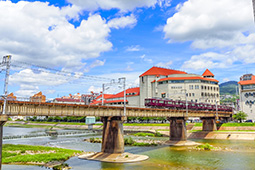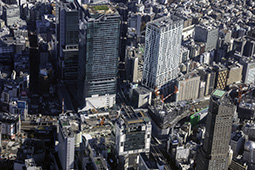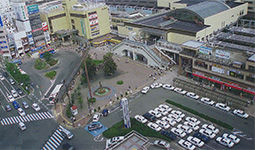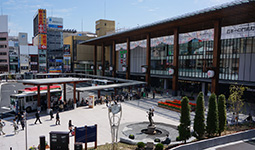February 2022
- English
- 日本語
Urban Development Centered Around Stations

View of Tokyo Station from the Marunouchi side 
Kishii Takayuki, Project Professor in the College of Science and Technology, Department of Civil Engineering at Nihon University

A Hankyu Railway train passes in front of Takarazuka Grand Theater in Hyogo Prefecture 
Shibuya Station undergoing redevelopment 
Nagano Station before redevelopment 
Nagano Station after redevelopment

Since the opening of Japan’s first railway 150 years ago, stations* have played a major role in the modernization of Japan, most notably in the development of its cities. We spoke with Kishii Takayuki, Project Professor in the College of Science and Technology, Department of Civil Engineering at Nihon University, about the relationship between urban development and railway stations in Japan.

Since the opening of Japan’s first railway line in 1872 connecting Shimbashi in Tokyo and Yokohama in Kanagawa Prefecture (a distance of 29 km), railways have spread across the country and the number of railway stations has increased. What role have railway stations played in the development of cities?
When railways began to spread in Tokyo at the end of the nineteenth century, tracks were laid in the periphery of the city where land could be secured, avoiding densely populated areas. So railway stations were also established in the city outskirts. Compared to now, Tokyo’s areas of dense population were very small, and stations such as Shinagawa, Shibuya and Shinjuku, which are now part of the metropolis, were originally located in areas with few residents or buildings.
In other words, when the history of railways began in Japan, the pattern was that a station would open and then a town would naturally form around it. However, Kobayashi Ichizo (1873–1957), the founder of the railroad company Hankyu Railway based in Osaka (where Expo 2025 will be held, see here), drastically changed this model. In 1911, the company opened the Takarazuka Line connecting Umeda Station in the center of Osaka City in Osaka Prefecture, with Takarazuka Station in the suburbs of Takarazuka City in Hyogo Prefecture. Kobayashi developed numerous business ventures along the rail line, including residential developments, department stores, and entertainment facilities such as hot springs, theaters and amusement parks. Kobayashi created a business model by which railway companies, in addition to building railways and train stations, stabilize their own operations by operating real estate and retail businesses along their rail lines to generate profits.

This business model also spread to Tokyo. After the city-center sustained massive damage from the Great Kanto Earthquake of 1923, various private railway companies constructed railway lines extending from the city center to the suburbs and conducted urban development along those lines.
Please tell us why urban development in Japan was centered on railroad stations?
In the United States, the use of automobiles became widespread in the 1920s, while in Japan, trains and buses were the chief means of transport until the 1970s. So, urban development happened mainly around railway stations where a higher concentration of people could gather. In the early 1990s, the American architect Peter Calthorpe proposed the concept of Transit-Oriented Development (TOD). The idea was to concentrate housing and commercial facilities around railway stations as a measure to mitigate environmental and energy problems caused by an over-reliance on motor vehicles. TOD went on to attract international attention, but the concept had been practiced in Japan for more than a century. Calthorpe himself identified Japan as a good example of TOD.
What are some features of recent large-scale redevelopment projects at major railway stations in Tokyo?
Major stations in central Tokyo were serviced by multiple railway companies, with each company undertaking independent development projects around its own station. As a result, the layout of the stations and their surrounding areas was very complex. However, more recent redevelopment projects being carried out at stations such as Tokyo, Shibuya and Shinjuku are being planned in cooperation with multiple railway companies, local governments, residents, and other concerned parties in order to increase the value of the stations and the areas around them. This has enabled the integrated design and comprehensive redevelopment of infrastructure such as railway facilities, station buildings, station front-plazas and parking lots.
An example is Marunouchi, on the west side of Tokyo Station, which functioned mainly as an office district. In 2012, construction work was completed to restore the Tokyo Station building to its original 1914 form, and in 2017, large pedestrian-friendly station front-plazas and an expansive pedestrianized space leading to the Outer Garden of the Imperial Palace were completed. These redevelopment projects have transformed Marunouchi into a neighborhood with fresh appeal. Various construction projects are also underway at Shibuya and Shinjuku Stations, including the relocation of platforms, the reconstruction of station buildings, and the construction of plazas and walkways to connect areas that had been divided by railway tracks. This is being achieved by land readjustment, altering the shape of parcels of land through the reorganization of landowners’ property rights. Shibuya and Shinjuku will be transformed into pleasant neighborhoods where everyone can transit and change trains safely and comfortably.

These projects go beyond just TOD to what may be called TODM (Transit-Oriented Development and Management), by involving all of the parties concerned in managing the development of the urban community. In order to sustainably increase the value of the area, it is important for railway stations, station front-plazas, and areas around stations to be designed and managed in an integrated manner.
Please tell us how stations in the suburbs of major cities and rural areas will change.
Until now, stations in the suburbs of major cities and rural areas have been transit points used by residents to travel between their homes and city centers or by people visiting sightseeing spots. However, as a result of social changes such as the advent of the super-aged society and the development of information and communication technology (ICT), stations and their surrounding areas where public transportation is concentrated must now provide multiple functions to support activities in the communities. Facilities are needed to provide daily-life services that include not only commercial facilities such as shops but also nursery centers, facilities for the elderly, remote working offices, community centers and other places like libraries, art galleries, and concert halls where various people gather, interact and share cultural experiences and the history of the community.
One example of a station in the rural area that communicates a sense of local culture and history is Nagano Station in Nagano Prefecture, for which I was involved in the redevelopment planning. Nagano Station is around an hour and a half from Tokyo by Shinkansen train and is a gateway to Zenkoji Temple, which boasts a history that goes back around 1,400 years. The temple’s Main Hall is a large wooden structure that is designated a national treasure, and Zenkoji attracts large numbers of people to worship throughout the year. Many people participated in the redevelopment, including railway company officials, experts and citizens, with the aim of transforming the station and station front into an iconic local feature. Completed in 2015, the station front-plaza has a canopied facade consisting of twelve columns and deep eaves built using locally produced wood, echoing the design of the Main Hall at Zenkoji. There is a public space on the third floor of the station building from the windows of which visitors can see the station front-plaza with its eaves and columns. The station communicates a sense of Nagano’s nature, culture, history and life, to both locals and visitors to Zenkoji Temple alike.


How do you think Japan’s expertise in using railway stations for urban development can contribute to overseas development, particularly in developing countries?
In cities in developing countries, automobiles became widespread before railway networks were developed, which has led to serious problems such as traffic accidents, traffic congestion and air pollution. As a result, Japan’s initiatives to promote urban development that puts emphasis on railways is generating great interest not only from developing countries themselves but also from the United Nations and the World Bank.
In order to respond to the needs of such developing countries, Japan is supporting urban development in major cities using railways, with the Japan International Cooperation Agency (JICA) playing a central role. One such example is Thailand, where JICA provides various kinds of support, including creating systems related to railroad construction and urban development. For example, JICA experts supported the drafting of a law on land readjustment that was passed by the Thai parliament in 2004. Land readjustment is essential to the construction of railways and associated urban development, so a law was needed to establish procedures and regulations for this. JICA experts did not transfer the Japanese law without modification, but made every effort to draft a law that was aligned with Thai society and culture. Since the law was passed, there has been a movement to integrate railway stations with development in surrounding areas, mainly in Bangkok.
In the face of serious environmental and energy problems, the world is moving toward urban development that incorporates public transportation. The model of urban development integrating railway networks established by Japan over many years is set to become increasingly important for the world.
* According to the Japan Geographic Data Center, as of January 2022, there are 9,171 stations in Japan

